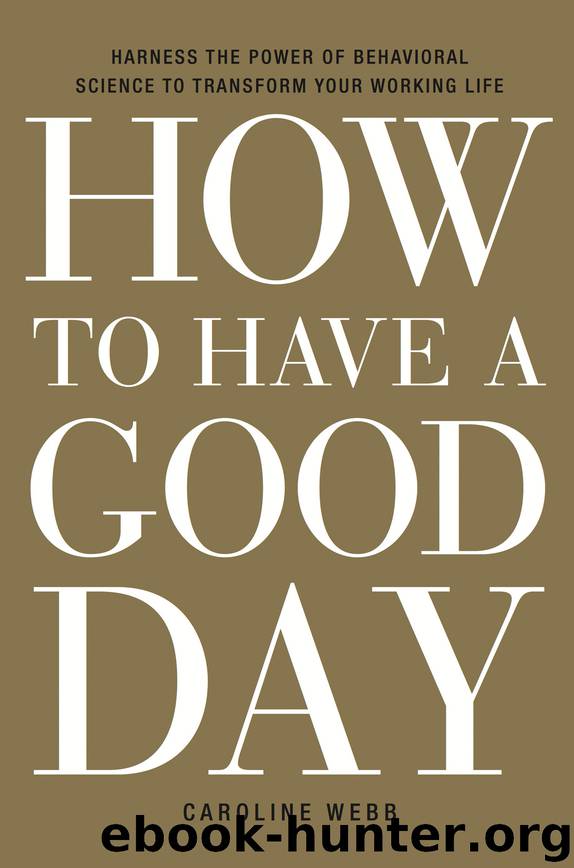How to Have a Good Day by Caroline Webb

Author:Caroline Webb
Language: eng
Format: epub
Publisher: The Crown Publishing Group
Published: 2016-02-01T16:00:00+00:00
One person that Charles Darwin would probably respect for his efforts to overcome cognitive shortcuts is Nayan, the chief financial officer of a global bank. During the day, Nayan makes complex business decisions about the right way to manage the bank’s finances. At home, he paints Hindu mandalas. His colleagues have nicknamed him “Yoda,” the epitome of wisdom and calm.
As with most senior managers, many of Nayan’s decisions revolve around people issues rather than balance sheets. “When I first joined the bank, I was told that one of my first tasks was to fire someone. The decision about this guy had been made before I came on board, and I was the new line manager, so it fell to me.” It would have been easy for Nayan to just accept that default instruction. After all, he was new, and of course he didn’t want to rock the boat. But despite hearing some strong language about this person’s behavior—he was apparently “arrogant”—it wasn’t clear to Nayan what substantive evidence sat behind that accusation. So he decided to do what he would normally do when making an important decision: he asked a lot of questions.
First, he acknowledged that the default option—to fire the guy—might still be the correct one. “But I wanted to map out all the options.” There was obviously “fire him” and “don’t fire him.” But under the “don’t fire him” option, Nayan mapped out a few different possibilities. “I think people were seeing this as a ‘do nothing’ option. But there were lots of potential ways to improve the situation, like coaching him or moving him to a different role, that didn’t involve him losing his job.”
Then Nayan gathered more information. “I spoke to a cross-section of his co-workers, and asked about his good points and bad points.” What did Nayan discover? “The guy was bright and decisive. Sometimes too decisive. But his team loved him and he was a great mentor to them.” As a result, Nayan believed it would be worth holding on to him if he was willing to do more to build bridges and work collaboratively. “The decision that was handed to me was based on perceptions more than evidence—some of his peers simply didn’t like his style,” Nayan said. When Nayan approached him, he was mortified to discover what people thought of him, and grateful to have a chance to put it right—which he did, within three months.
Download
This site does not store any files on its server. We only index and link to content provided by other sites. Please contact the content providers to delete copyright contents if any and email us, we'll remove relevant links or contents immediately.
| Business School Guides | GMAT |
| Guides | Interviewing |
| Job Hunting | Job Markets & Advice |
| Resumes | Vocational Guidance |
| Volunteer Work |
The Motivation Myth by Jeff Haden(4521)
Audition by Ryu Murakami(4091)
Adulting by Kelly Williams Brown(3663)
The Confidence Code by Katty Kay(3560)
Waiting in the Wings by Melissa Brayden(2802)
A Mind For Numbers: How to Excel at Math and Science (Even If You Flunked Algebra) by Barbara Oakley(2688)
Self-Esteem by Matthew McKay & Patrick Fanning(2598)
Nice Girls Don't Get the Corner Office by Lois P. Frankel(2589)
The ONE Thing by Gary Keller(2512)
The Dictionary of Body Language by Joe Navarro(2426)
Fooled by Randomness: The Hidden Role of Chance in Life and in the Markets by Nassim Nicholas Taleb(2407)
How to be More Interesting by Edward De Bono(2350)
Getting Things Done by David Allen(2314)
Designing Your Life by Bill Burnett(2259)
The Plant Paradox by Dr. Steven R. Gundry M.D(2035)
Police Exams Prep 2018-2019 by Kaplan Test Prep(2028)
What Color Is Your Parachute? 2015 by Richard N. Bolles(1923)
Dangerous Personalities by Joe Navarro(1890)
When to Jump by Mike Lewis(1803)
